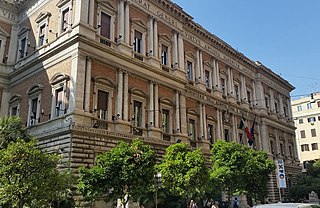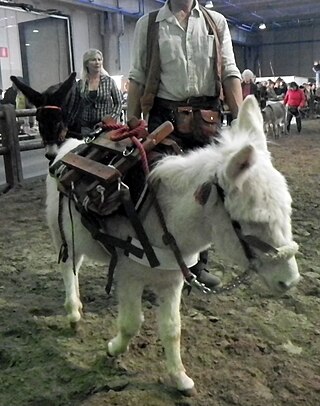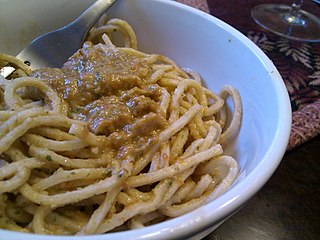Related Research Articles
The Viterbese or Italian: Asino Viterbese is a breed of donkey from Lazio in central Italy. It is particularly associated with the town and province of Viterbo from which it takes its name, and with the Monti della Tolfa and the town of Allumiere in the province of Rome. In 2007 it was reported by the FAO as extinct. In 2012 it was added to the list of autochthonous donkey breeds of limited distribution recognised by the Ministero delle Politiche Agricole Alimentari e Forestali, the Italian ministry of agriculture and forestry. A total population of 153 head was reported in the same year.

The Ministry of Agriculture, Food Sovereignty and Forests, Italian: Ministero dell'agricoltura, della sovranità alimentare e delle foreste or MASAF, is an Italian government department.

The Asinara, Italian: Asino dell'Asinara, is a breed of feral donkey indigenous to the island of Asinara, which lies off the north-west coast of Sardinia, Italy, in the province of Sassari. Most of the population is wholly or partly albinistic; the small number of grey donkeys on the island are also considered part of the population, and may be heterozygous carriers of the albino gene. The Asinara is one of the eight autochthonous donkey breeds of limited distribution recognised by the Ministero delle Politiche Agricole Alimentari e Forestali, the Italian ministry of agriculture and forestry. It is called ainu, borricu or molenti in Sardinian.

The Italian Landrace is an Italian breed of domestic pig. It derives from the Danish Landrace breed developed in Denmark at the end of the nineteenth century. Stock was imported into Italy after the Second World War. The breed has been selected principally for suitability for the production of prosciutto crudo. It is, after the Large White Italiana, the second-most numerous pig breed in Italy. The breed standard is issued by the Ministero delle Politiche Agricole Alimentari e Forestali, the Italian ministry of agriculture and forestry; the herdbook is kept by the Associazione Nazionale Allevatori Suini, the national pig-breeders' association.

The Cinta Senese is a breed of domestic pig from the province of Siena, in Tuscany, central Italy. Since 2006 animals raised in Tuscany have had DOP status, and are officially named Suino Cinto Toscano DOP. The Cinta Senese is one of the six autochthonous pig breeds recognised by the Ministero delle Politiche Agricole Alimentari e Forestali, the Italian ministry of agriculture and forestry.

The Ragusano is a breed of donkey from the Mediterranean island of Sicily. It is associated particularly with the comuni of Modica, Ragusa, Santa Croce Camerina and Scicli, all in the Province of Ragusa in southern Sicily. It is one of the eight autochthonous donkey breeds of limited distribution recognised by the Ministero delle Politiche Agricole Alimentari e Forestali, the Italian ministry of agriculture and forestry. The Ragusano was listed as "endangered" by the FAO in 2007.
The Pantesco or Asino di Pantelleria is an Italian breed of donkey from the Mediterranean island of Pantelleria, south-west of Sicily. It is at high risk of extinction and was listed as "critical" by the FAO in 2007. It is one of the eight autochthonous donkey breeds of limited distribution recognised by the Ministero delle Politiche Agricole Alimentari e Forestali, the Italian ministry of agriculture and forestry.

The Romagnolo or Asino Romagnolo is a breed of donkey from Emilia-Romagna in northern Italy. It is raised mainly in the province of Forlì-Cesena, but also the provinces of Metropolitan City of Bologna, and the provinces of Ravenna and Reggio Emilia. It is one of the eight autochthonous donkey breeds of limited distribution recognised by the Ministero delle Politiche Agricole Alimentari e Forestali, the Italian ministry of agriculture and forestry. The conservation status of the Romagnolo was listed as "critical" by the FAO in 2007.

The Sardinian is an Italian breed of donkey from the Mediterranean island of Sardinia, to the west of Italy. It is raised throughout the island; there are also some small populations in mainland Italy. It is one of the eight autochthonous donkey breeds of limited distribution recognised by the Ministero delle Politiche Agricole Alimentari e Forestali, the Italian ministry of agriculture and forestry. Its conservation status was listed as 'endangered' by the FAO in 2007 and as 'at risk/endangered' in DAD-IS in 2024. The breeding population reported for 2022 numbered just over 3600 head, with 2094 jennies and 963 jacks in 788 herds.
The Grigio Siciliano or Asino Ferrante, is a breed of donkey from the Mediterranean island of Sicily in southern Italy. It is bred only on the island, in the provinces of Agrigento, Enna, Palermo, Ragusa and Syracuse. The conservation status of the Grigio Siciliano was listed as "critical" by the FAO in 2007. In 2012 it was not among the autochthonous donkey breeds of limited distribution recognised by the Ministero delle Politiche Agricole Alimentari e Forestali, the Italian ministry of agriculture and forestry. A recent census conducted by researchers at the University of Messina counted approximately 100 individuals between 4 months and 14 years old.

The Nero di Parma is a breed of pig from the province of Parma, in the Italian region of Emilia-Romagna. It is a modern recreation of the ancient Nera Parmigiana breed, which became effectively extinct in the second half of the twentieth century, following the importation of pig breeds from Britain, though it is still listed in DAD-IS. From the mid-1990s, the breed was re-created from a small number of primitive animals located in the areas of Santa Margherita di Fidenza, Bardi, and Pellegrino Parmense, and in 2008 numbered about 300. A herdbook is kept by the Associazione Nazionale Allevatori Suini, the Italian national association of pig-breeders. It is not among the pig breeds recognised by the Ministero delle Politiche Agricole Alimentari e Forestali, the Italian ministry of agriculture and forestry.

The Mora Romagnola is a breed of pig from Emilia-Romagna, in northern Italy. It may also be called Mora, Bruna Romagnola, Castagnina or Forlivese. It is raised principally in Emilia–Romagna, but also in Campania, Friuli–Venezia Giulia, Lombardy, the Marche, Piemonte and the Veneto. It is one of the six autochthonous pig breeds recognised by the Ministero delle Politiche Agricole Alimentari e Forestali, the Italian ministry of agriculture and forestry.

The Nero Siciliano is a breed of domestic pig from the Mediterranean island of Sicily, in southern Italy. It is raised mainly in the province of Messina, particularly in the Monti Nebrodi. For this reason it is often known as the Nero dei Nebrodi; it may also be called Nero delle Madonie or Nero dell'Etna, for its association with the Madonie mountains and mount Etna respectively. It is one of the six autochthonous pig breeds recognised by the Ministero delle Politiche Agricole Alimentari e Forestali, the Italian ministry of agriculture and forestry.

Pesto alla trapanese is a Sicilian variation of pesto, typical of the province of Trapani. It is also known as pesto trapanese and pesto alla siciliana, and as pasta cull'agghia in the Sicilian language. It is made of garlic, basil, almonds, grated pecorino siciliano, tomatoes, salt, and black pepper, and bound with extra virgin olive oil.
The Apulo-Calabrese is a breed of black domestic pig from Calabria, in southern Italy. It may also be known as the Calabrese, Nero Calabrese or Nero di Calabria, and by many other regional names. It derives from the old Pugliese pig breed of Puglia, which in turn derives from the Casertana breed of Campania; it is closely related to that breed. The Apulo-Calabrese is one of the six autochthonous pig breeds recognised by the Ministero delle Politiche Agricole Alimentari e Forestali, the Italian ministry of agriculture and forestry.
The Large White Italiana is the Italian strain of the British Large White or Yorkshire breed of pig. It is the most numerous pig breed in Italy. It is one of the seven pig breeds of foreign origin recognised by the Ministero delle Politiche Agricole Alimentari e Forestali, the Italian ministry of agriculture and forestry, and one of the four for which a genealogical herdbook is kept by the Associazione Nazionale Allevatori Suini, the Italian national association of pig-breeders.
The Casertana is a breed of domestic pig from Campania, in southern Italy. It is mainly associated with the province of Caserta, from which its name derives, but was in the past also raised in the provinces of Campobasso, Naples, Rome and Salerno. The area of the lower basin of the Garigliano and Volturno rivers, including the comuni of Carinola, Mondragone, Minturno, Sessa Aurunca and Teano, was particularly known for production of the breed, which may also be known as the Teanese after the town of Teano.
The Duroc Italiana is the Italian strain of the American Duroc breed of domestic pig. It is the third most numerous pig breed in Italy, after the Large White Italiana and the Italian Landrace. It is one of the seven pig breeds of foreign origin recognised by the Ministero delle Politiche Agricole Alimentari e Forestali, the Italian ministry of agriculture and forestry, and one of the four for which a genealogical herdbook is kept by the Associazione Nazionale Allevatori Suini, the Italian national association of pig-breeders.
References
- ↑ Tredicesima revisione dell'elenco dei prodotti agroalimentari tradizionali Archived 27 September 2013 at the Wayback Machine (in Italian). Rome: Ministero delle politiche agricole alimentari e forestali. Accessed June 2014.
- 1 2 Allegato al decreto PAT 2019 (in Italian). Ministero delle politiche agricole alimentari, forestali e del turismo. Accessed November 2021.